Geological Risk Calculation through Probability of Success (PoS), Applied to Radioactive Waste Disposal in Deep Wells: A Conceptual Study in the Pre-Neogene Basement in the Northern Croatia
Abstract
1. Introduction
- PoS
- - geological probability of success (%);
- p(t)
- - probability of potential traps (%);
- p(r)
- - probability of reservoir characteristics (%);
- p(m)
- - the probability of hydrocarbon migration (%);
- p(sr)
- - the probability of the existence of source rocks (%);
- p(CHp)
- - the probability of hydrocarbon preservation (%).
2. Geological Samples of the Pre-Neogene Basement Rocks in Northern Croatia
3. Basic Geological Settings of the Pre-Neogene Basement Rock in the Northern Croatia
4. Lithology and Petrophysics of the Pre-Neogene Basement Rock in the Northern Croatia
5. Proposal and Discussion of a Modified PoS Methodology for Radioactive Waste Disposal in Pre-Neogene Basement of the Northern Croatia
5.1. Connections between Categories in Classical and Modified PoS Models (Hydrocarbon vs. DBD Critical Variables)
5.2. The New Categories and Critical Variables
5.3. Probability Classes in the Proposed Categories
6. Conclusions
Author Contributions
Funding
Acknowledgments
Conflicts of Interest
References
- Malvić, T. Oil-Geological Relations and Probability of Discovering New Hydrocarbon Reserves in the Bjelovar Sag. Ph.D. Thesis, University of Zagreb, Faculty of Mining, Geology and Petroleum Engineering, Zagreb, Croatia, 2003. (In Croatian, with Abstract in English). [Google Scholar]
- Malvić, T. Stochastical approach in deterministic calculation of geological risk-theory and example. Nafta 2009, 60, 658–662. [Google Scholar]
- Malvić, T.; Rusan, I. Investment risk assessment of potential hydrocarbon discoveries in a mature basin. Case study from the Bjelovar Sub-Basin, Croatia. Oil GasEur. Mag. (Hambg.) 2009, 35, 67–72. [Google Scholar]
- Malvić, T.; Velić, J. Stochastically improved methodology for probability of success (POS) calculation in hydrocarbon systems. RMZ–Mater. Geoenviron. 2015, 62, 149–155. [Google Scholar]
- Novak Mavar, K. Surface Transportation Modelling and Geological Aspects of Carbon-Dioxide Storage into Northern Croatian Neogene Sandstone Reservoirs, Case Study Ivanić Field. Ph.D. Thesis, University of Zagreb, Zagreb, Croatia, 2015. (In Croatian, with Abstract in English). [Google Scholar]
- Malvić, T.; Velić, J.; Režić, M. Geological probability calculation of new gas discoveries in wider area of Ivana and Ika Gas Fields, Northern Adriatic, Croatia. RMZ–Mater. Geoenviron. 2016, 63, 127–138. [Google Scholar] [CrossRef]
- Režić, M.; Varenina, A. A new freeware program for the Probability of Success calculation of new gas discoveries within the Croatian part of the Po depression. Rud. Geol. Naft. Zb. 2017, 32, 49–55. [Google Scholar] [CrossRef]
- Ivšinović, J. Selection and Geomathematical Calculation of Variables for Sets with Less than 50 Data Regarding the Creation of an Improved Subsurface Model, Case Study from the Western Part of the Sava Depression. Ph.D. Thesis, University of Zagreb, Faculty of Mining, Geology and Petroleum Engineering, Zagreb, Croatia, 2019. (In Croatian, with Abstract in English). [Google Scholar]
- Malvić, T.; Ivšinović, J.; Velić, J.; Sremac, J.; Barudžija, U. Increasing Efficiency of Field Water Re-Injection during Water-Flooding in Mature Hydrocarbon Reservoirs: A Case Study from the Sava Depression, Northern Croatia. Sustainability 2020, 12, 786. [Google Scholar] [CrossRef]
- GOVERNMENT OF THE REPUBLIC OF CROATIA. National Program for the Implementation of the Radioactive Waste, Disused Sources and Spent Nuclear Fuel Disposal Strategy (Program for the Period until 2025 with a View to 2060). Official Gazette 2018, 100, 69. Available online: https://narodne-novine.nn.hr/clanci/sluzbeni/2018_11_100_1954.html (accessed on 28 June 2020). (In Croatian).
- ARAO & Fond NEK Third Revision of the Krško NPP Radioactive Waste and Spent Fuel Disposal Program, ver. 1.3, ARAO Doc.No. 19-1/08-01-002, FOND NEK Doc.No. 3-1/19-2-4/18. 2019. Available online: https://mzoe.gov.hr/UserDocsImages/UPRAVA%20ZA%20ENERGETIKU/Strategije,%20planovi%20i%20programi/Treca_revizija%20Programa_odlaganja_radio%20aktivnog%20goriva_i_istrošenog%20nuklearnog%20goriva%20NEK-EN.pdf (accessed on 28 June 2020).
- CROATIAN PARLIAMENT. Radioactive Waste, Disused Sources and Spent Nuclear Fuel Disposal Strategy (Program for the Period until 2025 with a View to 2060). Official Gazette 2014, 125. [Google Scholar]
- ARAO. Inventory of SF and HLW for possible Deep Borehole Disposal-Slovenia. In Prepared by ARAO for the Purpose of ERDO Joint Project on Deep Borehole Disposal Lead by NND Norway. 20-08-004-001; Croatian Geological Survey: Ljubljana, Slovenia, 2011; p. 19. [Google Scholar]
- Galamboš, M.; Rosskopfová, O.; Kufčáková, J.; Rajec, P. Utilization of Slovak bentonites in deposition of high-level radioactive waste and spent nuclear fuel. J. Radioanal. Nucl. Chem. 2011, 288, 765–777. [Google Scholar] [CrossRef]
- Adamcová, R.; Suraba, V.; Krajňák, A.; Rosskopfová, O.; Galamboš, M. First shrinkage parameters of Slovak bentonites considered for engineered barriers in the deep geological repository of high-level radioactive waste and spent nuclear fuel. J. Radioanal. Nucl. Chem. 2014, 302, 737–743. [Google Scholar] [CrossRef]
- Geological Map of the Republic of Croatia at a Scale 1:300.000; Croatian Geological Survey: Zagreb, Croatia, 2009; Available online: http://webgis.hgi-cgs.hr/gk300/default.aspx (accessed on 28 June 2020). (In Croatian)
- Guide to the Geological Map of the Republic of Croatia at a scale 1:300.000; Velić, I., Vlahović, I., Eds.; Croatian Geological Survey: Zagreb, Croatia, 2009; p. 141. (In Croatian) [Google Scholar]
- Šikić, K. Prikaz geološke građe Medvednice [Overview of geological structure of the Medvednica Mt.]. In Geološki Vodič Medvednice [Geological Guide for Medvednica Mt.]; Šikić, K., Ed.; Croatian Geol. Institute & INA Petroleum Comp.: Zagreb, Croatia, 1995; pp. 7–40. (In Croatian) [Google Scholar]
- Fuček, L.; Tišljar, J.; Sokač, B.; Prtoljan, B.; Oštrić, N. Upper Triassic dolomites in Podsused Quarry (Stop 1). In Geological Guide for Medvednica Mt; Šikić, M., Ed.; Croatian Geological Institute & INA Petroleum Comp.: Zagreb, Croatia, 1995; pp. 41–43. (In Croatian) [Google Scholar]
- Tomljenović, B. Structural Characteristics of Medvednica and Samoborsko Gorje Mountains. Ph.D. Thesis, University of Zagreb, Faculty of Mining, Geology and Petroleum Engineering, Zagreb, Croatia, 2002. (In Croatian, with Abstract in English). [Google Scholar]
- Maričić, A.; Starčević, K.; Barudžija, U. Physical and mechanical properties of dolomites related to sedimentary and diagenetic features—case study of the Upper Triassic dolomites from Medvednica and Samobor Mts., NW Croatia. Rudarsko-geološko-naftni Zb. (Mining-Geological-Petroleum Eng. Bull.) 2018, 33, 33–44. [Google Scholar] [CrossRef]
- Grgasović, T. Stratigraphy of the Upper Triassic deposits of Žumberak. Master of Science Thesis, University of Zagreb- Faculty of Science, Zagreb, Croatia, 1998. (In Croatian, with Abstract in English). [Google Scholar]
- Pavičić, I.; Dragičević, I.; Vlahović, T.; Grgasović, T. Fractal analysis of fracture systems in Upper Triassic Dolomites in Žumberak Mountain, Croatia. Rudarsko-geološko-naftni Zb. (Mining-Geological-Petroleum Eng. Bull.) 2017, 32, 1–13. [Google Scholar] [CrossRef]
- Barudžija, U.; Velić, J.; Malvić, T.; Trenc, N.; Matovinović Božinović, N. Morphometric Characteristics, Shapes and Provenance of Holocene Pebbles from the Sava River Gravels (Zagreb, Croatia). Geosciences 2020, 10, 92. [Google Scholar] [CrossRef]
- Barudžija, U.; Bočić, N.; Macek, K.; Repinc, I.; Smirčić, D. Triassic carbonate complex of the Papuk Mts. (Outcrops along Velika—Slatinski Drenovac road). In 5th Croatian Geological Congress—Fieldtrip Guidebook; Horvat, M., Galović, L., Eds.; Croatian Geological Survey: Zagreb, Croatia, 2015; pp. 55–64. [Google Scholar]
- Šegvić, B. Petrology and Geochemistry of the Greenschists from the Central Part of the Medvednica Mts. Master of Science Thesis, University of Zagreb, Faculty of Mining, Geology and Petroleum Engineering, Zagreb, Croatia, 2003. (In Croatian, with Abstract in English). [Google Scholar]
- Mišur, I. Geodinamic Evolution of Low-Grade Metamorphism Metasedimentary Rocks in the Medvednica Mts. Ph.D. Thesis, University of Zagreb, Faculty of Science, Zagreb, Croatia, 2017. (In Croatian, with Abstract in English). [Google Scholar]
- Šuica, S. Granitoids of the Pannonian Basin Basement in the Eastern Croatia. Ph.D. Thesis, University of Zagreb, Faculty of Mining, Geology and Petroleum Engineering, Zagreb, Croatia, 2019. (In Croatian, with Abstract in English). [Google Scholar]
- Malvić, T. Strukturni i Tektonski Odnosi te Značajke Ugljikovodika Širega Područja Naftnoga Polja Galovac-Pavljani [Structural and tectonic relations and characteristics of hydrocarbons in the wider area of the Galovac-Pavljani oil field]. Master of Science Thesis, University of Zagreb, Faculty of Mining, Geology and Petroleum Engineering, Zagreb, Croatia, 1998. (In Croatian, with Abstract in English). [Google Scholar]
- Malvić, T. Regional geological settings and hydrocarbon potential of Bjelovar sag (subdepression), R. Croatia. Nafta 2004, 55, 273–288. [Google Scholar]
- Malvić, T. Review of Miocene shallow marine and lacustrine depositional environments in Northern Croatia. Geol. Q. 2012, 56, 493–504. [Google Scholar] [CrossRef]
- Pavelic, D. Tectonostratigraphic model for the North Croatian and North Bosnian sector of the Miocene Pannonian Basin System. Basin Res. 2001, 13, 359–376. [Google Scholar] [CrossRef]
- Pavelic, D.; Miknic, M.; Sarkotic Šlat, M. Early to Middle Miocene facies succession in lacustrine and marine environments on the southwestern margin of the Pannonian basin system. Geol. Carpathica 1998, 49, 433–443. [Google Scholar]
- Vrbanac, B. Paleostrukturne i Sedimentološke Analize Gornjopanonskih Naslaga Formacije Ivanić Grad u Savskoj Depresiji [Paleostructural and sedimentological analyzes of the Upper Pannonian deposits of the Ivanić grad Formation in the Sava Depression]. Ph.D. Thesis, University of Zagreb, The Faculty of Science, Zagreb, Croatia, 1996. (In Croatian, with Abstract in English). [Google Scholar]
- Prelogovic, E. Neotektonska karta SR Hrvatske [Neotectonic map of SR Croatia]. Geol. Vjesn. 1975, 28, 97–108. (In Croatian) [Google Scholar]
- Malvić, T.; Cvetković, M. Lithostratigraphic units in the Drava Depression (Croatian and Hungarian parts)—A correlation. Nafta 2013, 64, 27–33. [Google Scholar]
- Malvić, T. Geological maps of Neogene sediments in the Bjelovar Subdepression (northern Croatia). J. Maps 2011, 304–317. [Google Scholar] [CrossRef]
- Pandžić, J. Podloga tercijara jugozapadnog dijela Panonskog bazena [Tertiary base of the southwestern part of the Pannonian Basin]. In Proceedings of the IV. God. Znanstvenog Skupa I. Sekc. ZSN JAZU—Stubičke Toplice, Zagreb, Croatia, 1978; pp. 33–44. (In Croatian). [Google Scholar]
- Hernitz, Z. Dubinski Strukturno-Tektonski Odnosi u Području Istočne SLAVONIJE [Deep structural-tectonic relations in the area of Eastern Slavonia]. Ph.D. Thesis, University of Zagreb, Zagreb, Croatia, 1983. (In Croatian). [Google Scholar]
- Malvić, T. Geološki Odnosi Područja Virovitica-Rezovačke Krčevine-Orešac [Geological relations of the area Virovitica-Rezovačke Krčevine-Orešac]. Master’s Thesis, University of Zagreb, Faculty of Mining, Geology and Petroleum Engineering, Zagreb, Croatia, 1995. (In Croatian, with Abstract in English). [Google Scholar]
- Malvić, T.; Sučić, A.; Cvetković, M.; Resanović, F.; Velić, J. Low permeability Neogene lithofacies in Northern Croatia as potential unconventional hydrocarbon reservoirs. Cent. Eur. J. Geosci. 2014, 6, 182–194. [Google Scholar] [CrossRef]
- Cota, L.; Britvić, V. Hidrodinamika i kemizam formacijskih voda Dravske potoline—Panonski bazen [Hydrodynamic and chemistry of Drava Depression formation waters—Pannonian Basin]. Nafta 1991, 42, 121–136, (In Croatian, with Abstract in English). [Google Scholar]
- Malvić, T. Ležišne vode naftnoga polja Galovac-Pavljani [Field water of the Galovac-Pavljani Field]. Hrvat. Vode 1999, 7, 139–148. (In Croatian) [Google Scholar]
- Malvić, T.; Velić, J. Relation between Effective Thickness, Gas Production and Porosity in Heterogeneous Reservoirs: An Example from the Molve Field, Croatian Pannonian Basin. Pet. Geosci. 2010, 16, 41–51. [Google Scholar] [CrossRef]
- White, D.A. Geologic Risking Guide for Prospects and Plays. AAPG Bull. 1993, 77/12, 2048–2061. [Google Scholar] [CrossRef]
- Hernitz, Z.; Bokor, N.; Malvić, T. Probability Evaluation of New Hydrocarbon Finds in Some Parts of Sava and Drava Depression. In Proceedings of the Working materials of the 2nd Int. Symposium on Petroleum Geology, Zagreb, Croatia, 22–24 April 1999; pp. 165–175. [Google Scholar]
- Malvić, T.; Rusan, I. Potential hydrocarbon discoveries in Bjelovar Subdepression, Croatia. Search Discov. 2007, 9, 1–6. [Google Scholar]
- Beswick, A.J.; Gibb, F.G.F.; Travis, K.P. Deep borehole disposal of nuclear waste: Engineering challenges. Energy 2014, 167, 47–66. [Google Scholar] [CrossRef]
- Wang, J. On area-specific underground research laboratory for geological disposal of high-level radioactive waste in China. J. Rock Mech. Geotech. Eng. 2014, 6, 99–104. [Google Scholar] [CrossRef]
- Zhao, X.G.; Wang, J.; Qin, X.; Cai, M.; Su, R.; He, J.; Zong, Z.; Ma, L.; Ji, R.; Zhang, M.; et al. In-situ Stress Measurements and Regional Stress Field Assessment in the Xinjiang Candidate Area for China’s HLW Disposal. Eng. Geol. 2015, 197, 42–56. [Google Scholar] [CrossRef]
- Gibb, F.G.F.; Travis, K.P.; McTaggart, N.A.; Burley, D.; Hesketh, K.W. High density support matrices: Key to deep borehole disposal of spent nuclear fuel. J. Nucl. Mater. 2008, 374, 370–377. [Google Scholar] [CrossRef][Green Version]
- Macenić, M.; Kurevija, T.; Strpić, K. Systematic review of research and utilization of shallow geothermal energy in Croatia. Rudarsko-geološko-naftni Zb. (Mining-Geological-Petroleum Eng. Bull.) 2018, 33, 37–46. [Google Scholar] [CrossRef]
- Borović, S.; Marković, T.; Larva, O.; Brkić, Ž.; Mraz, V. Mineral and Thermal Waters in the Croatian Part of the Pannonian Basin. In Mineral and Thermal Waters of Southeastern Europe; Papić, P., Ed.; Springer: Berlin/Heidelberg, Germany, 2016; pp. 31–45, 174. [Google Scholar]
- Franklin, W.S.; Yongje, K.; Byung-Gon, C. Deep Borehole Disposal of Nuclear Wastes: Opportunities and Challenges. J. Nucl. Fuel Cycle Waste Technol. 2017, 15, 301–312. [Google Scholar] [CrossRef]
- U.S. Nuclear Waste Technical Review Board (NWTRB). Technical evaluation of the U.S. Department of Energy deep borehole disposal research and development program. In A Report to the U.S. Congress and the Secretary of Energy; NWTRB: Arlington, VA, USA, 2016. [Google Scholar]
- Tatarinov, V.N.; Morozov, V.N.; Manevich, A.I.; Tatarinova, T.A. Underground Research Laboratory: To the Program of Geomechanical Research. Radioact. Waste 2019, 2, 82–96. [Google Scholar] [CrossRef]
- Gibb, F.G.F.; Travis, K.P.; McTaggart, N.A.; Burley, D. A model for heat flow in deep borehole disposals of high-level nuclear waste. J. Geophys. Res. 2008, 113, B05201. [Google Scholar] [CrossRef]
- Gibb, F.G.F.; Travis, K.P.; Hesketh, K.W. Deep borehole disposal of higher burn up spent nuclear fuels. Mineral. Mag. 2012, 76, 3003–3017. [Google Scholar] [CrossRef]
- Brady, P.V.; Arnold, B.W.; Freeze, G.A.; Swift, P.N.; Bauer, S.J.; Kanney, J.L.; Rechard, R.P.; Stein, J.S. Deep Borehole Disposal of High-Level Radioactive Waste; SAND2009-4401; Sandia National Laboratories: Albuquerque, NM, USA, 2009; p. 74. [Google Scholar]
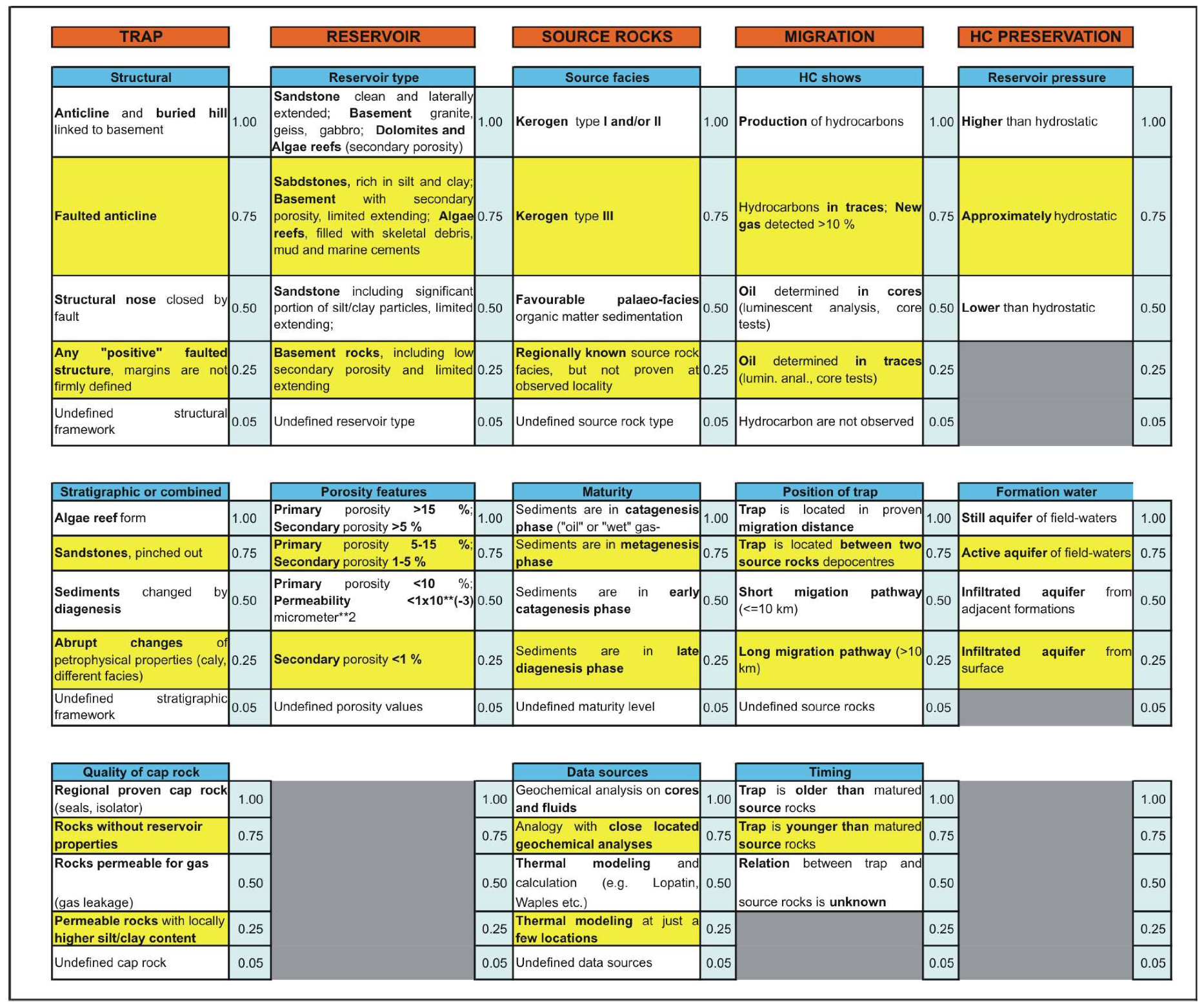
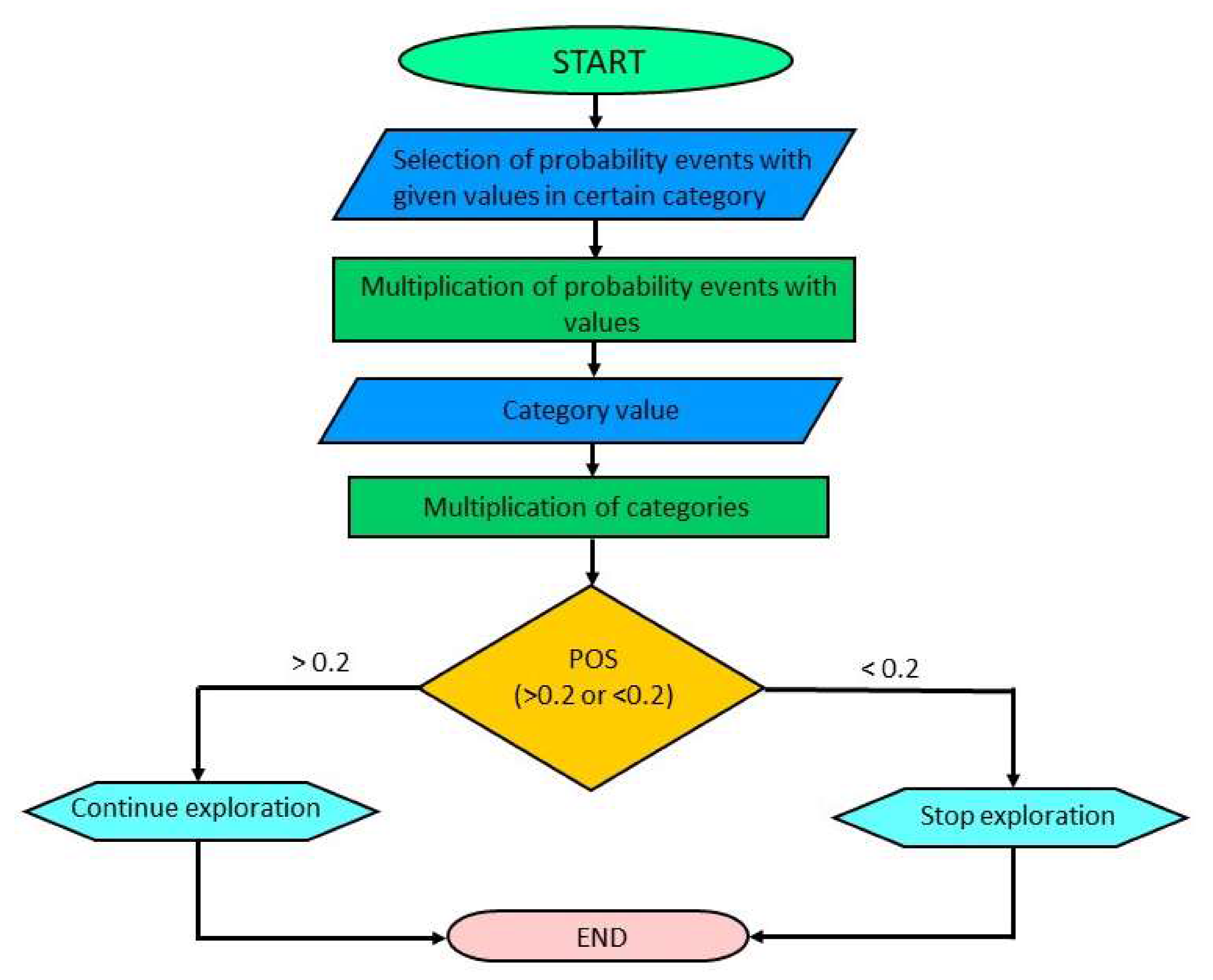
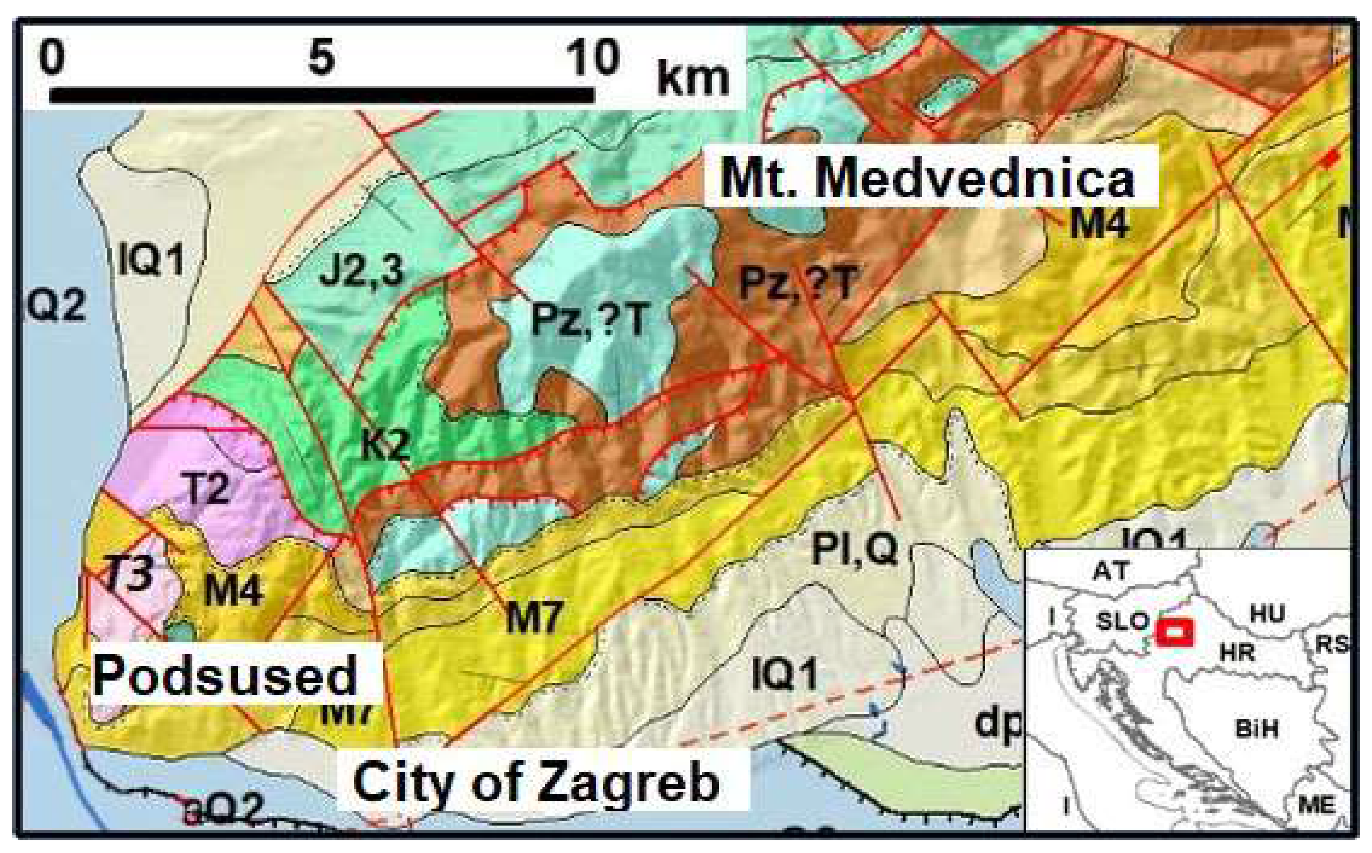
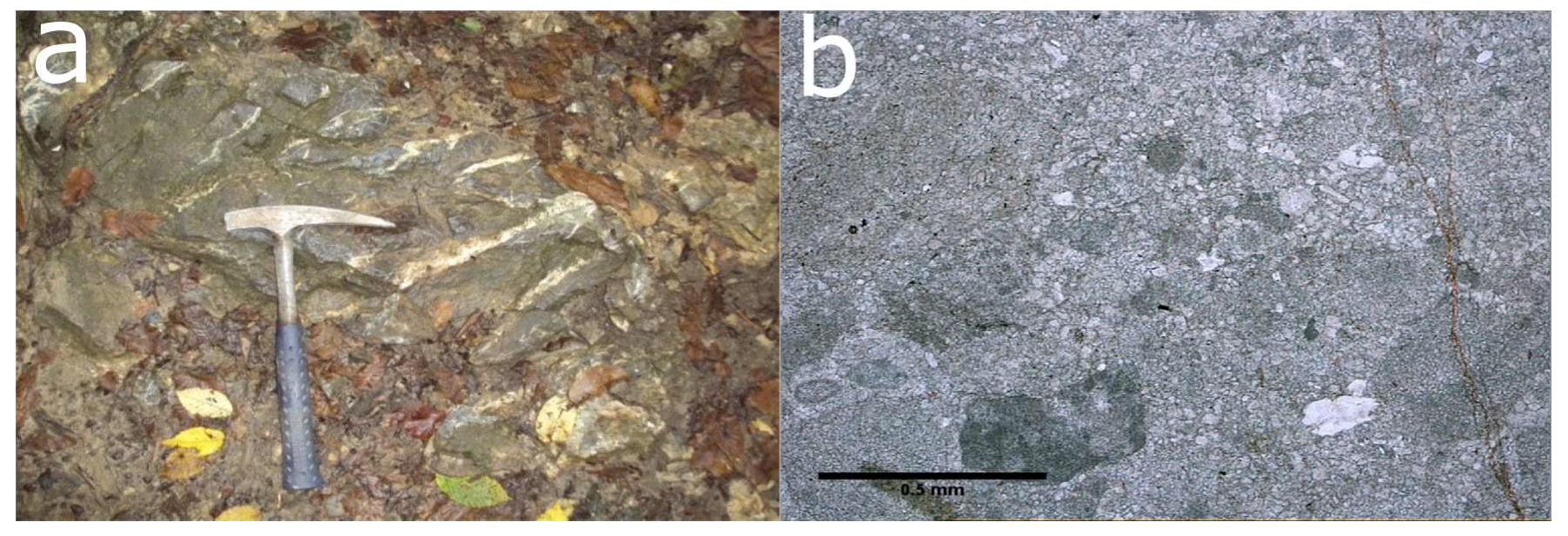
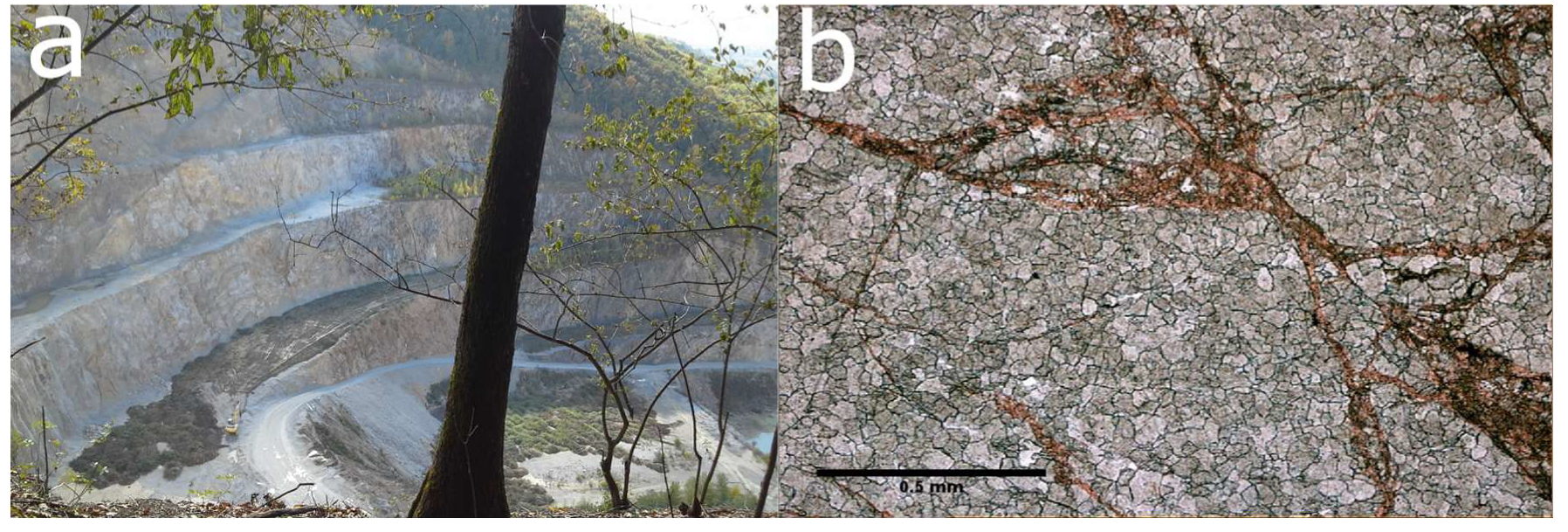
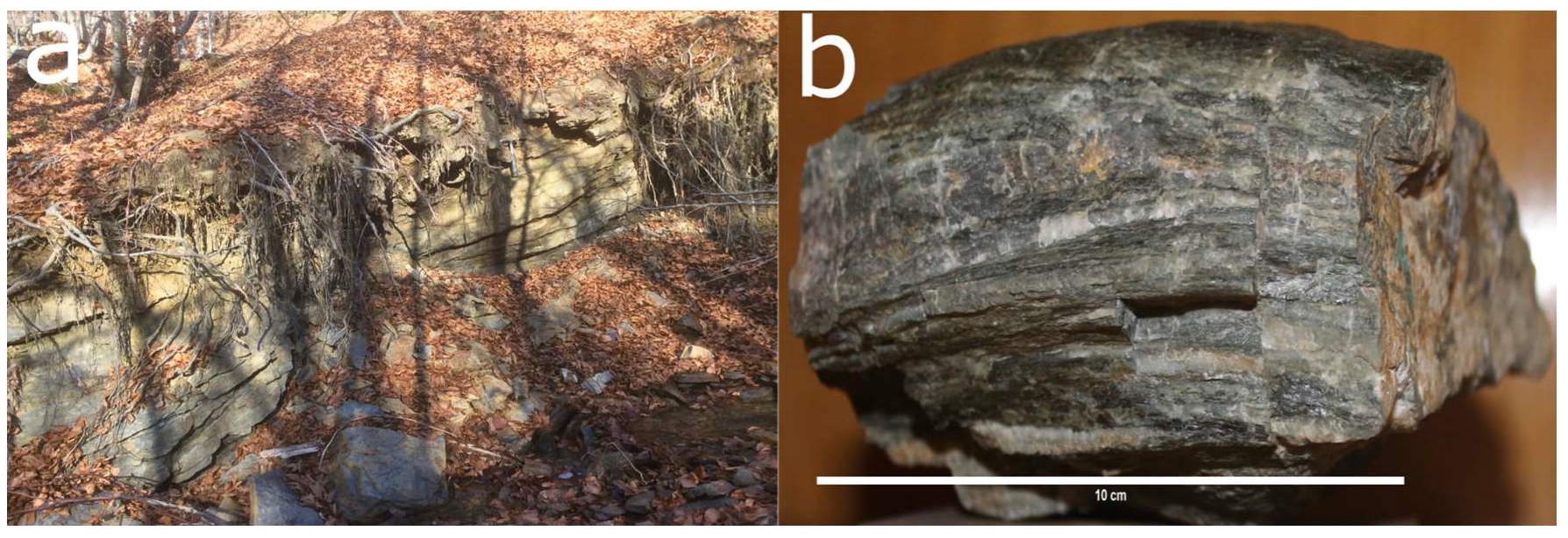
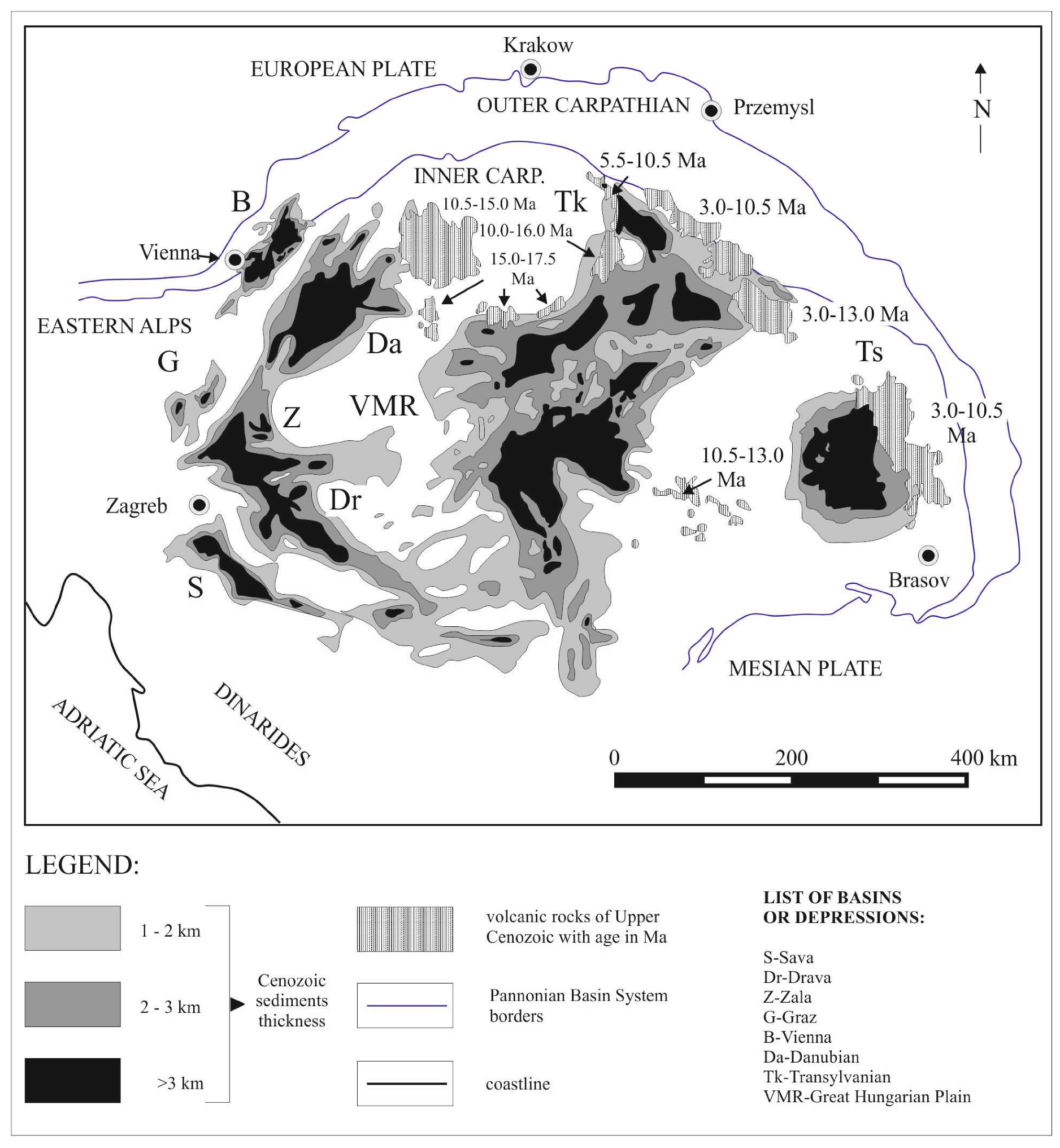
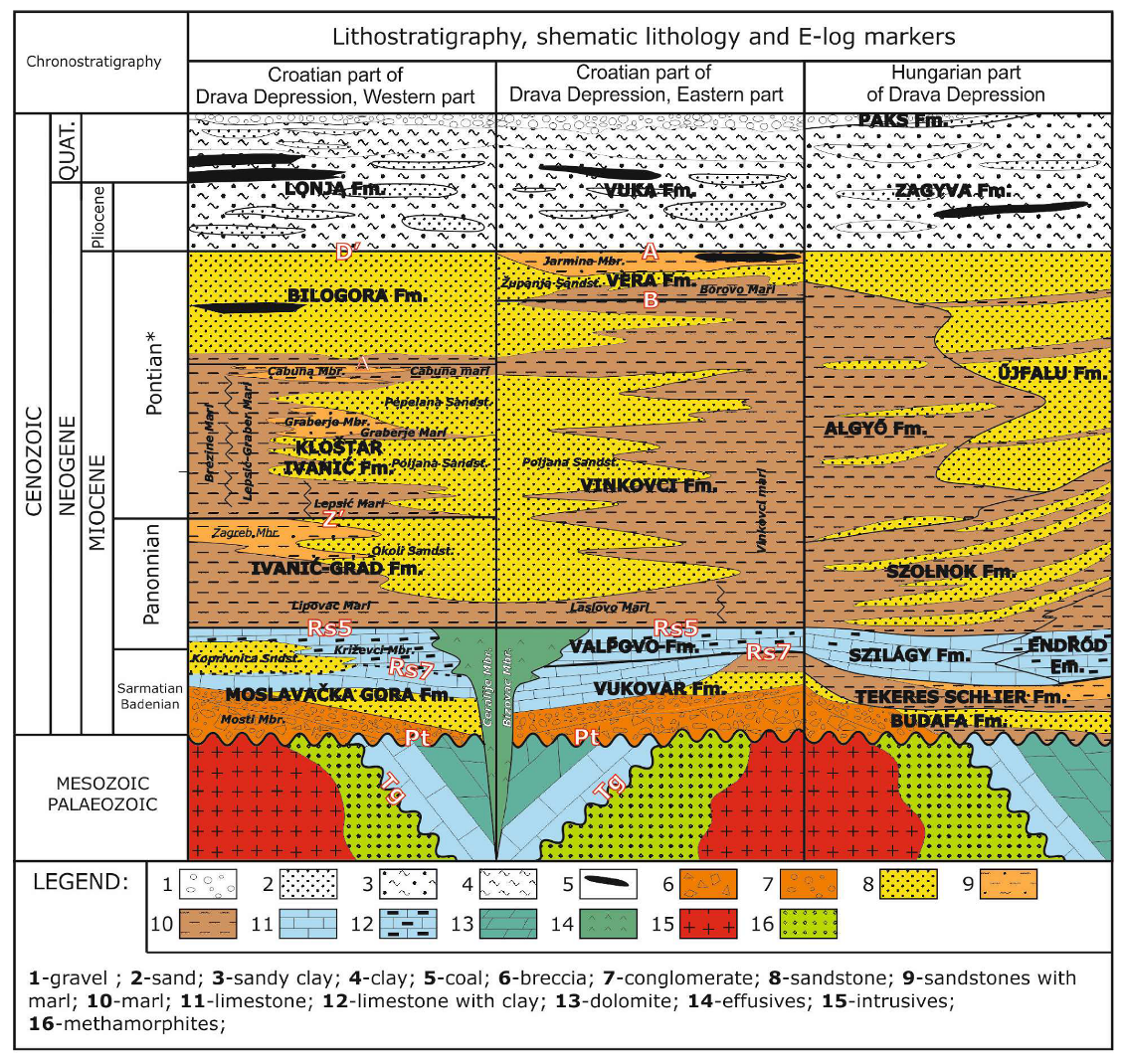
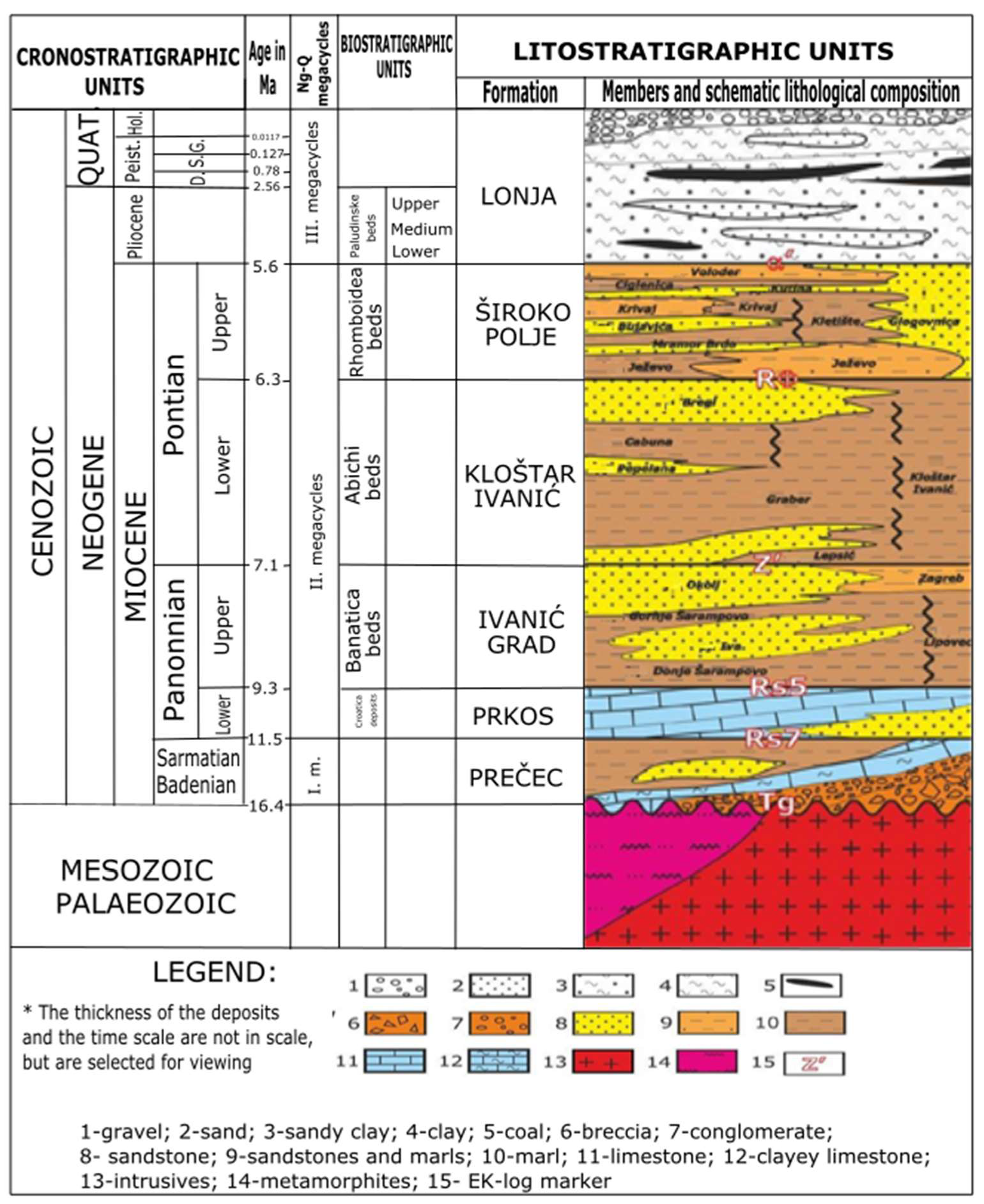
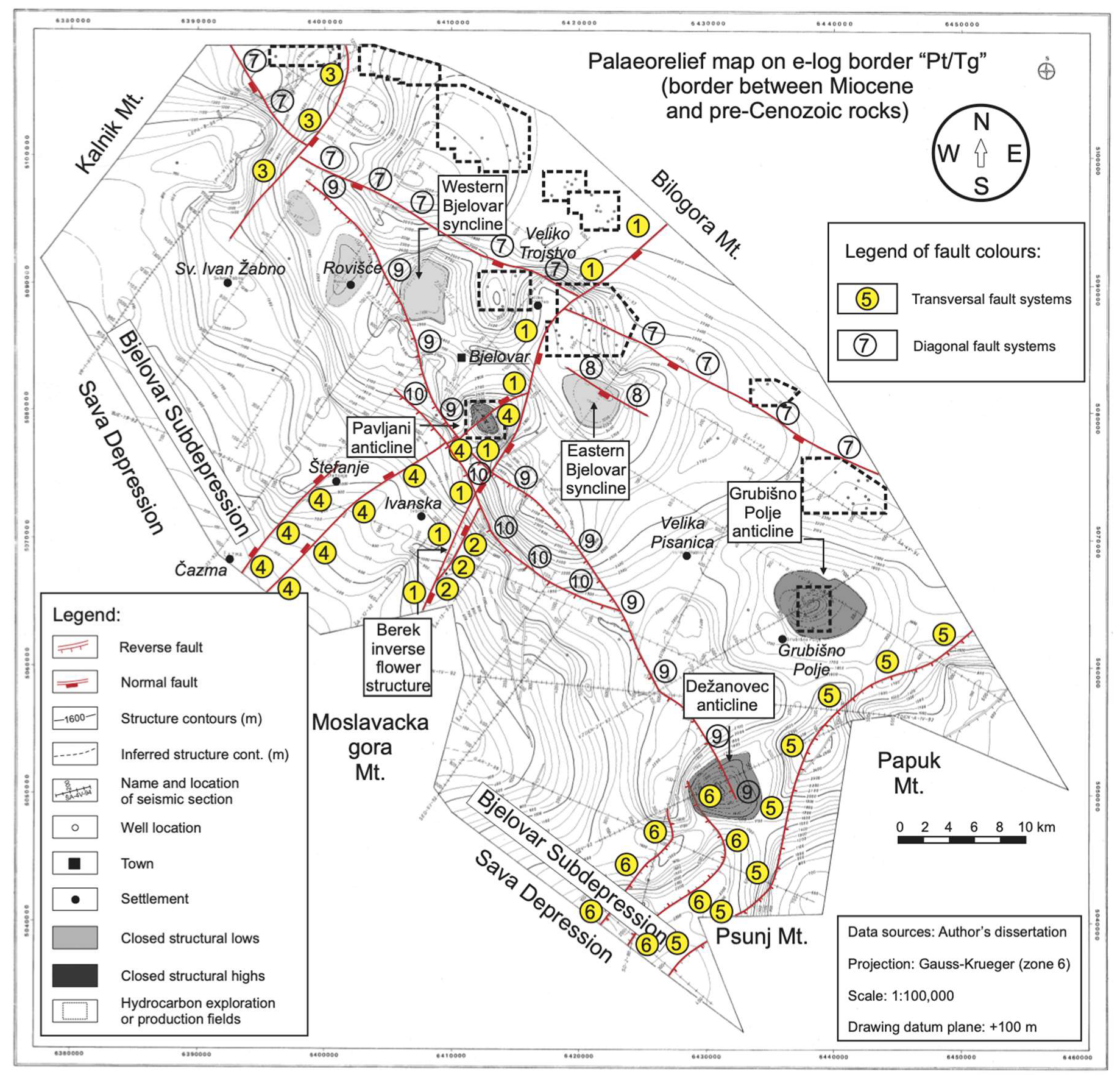
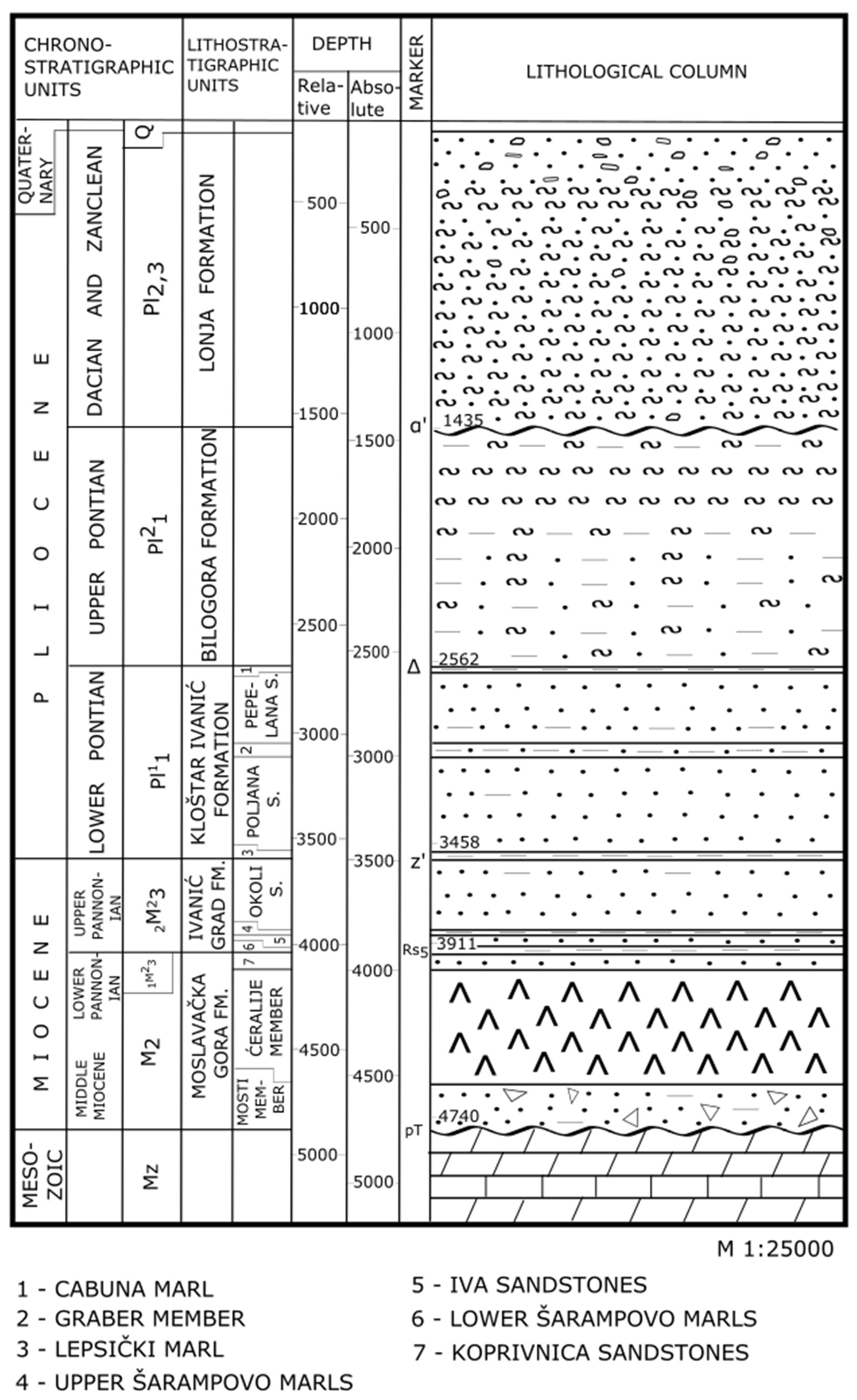
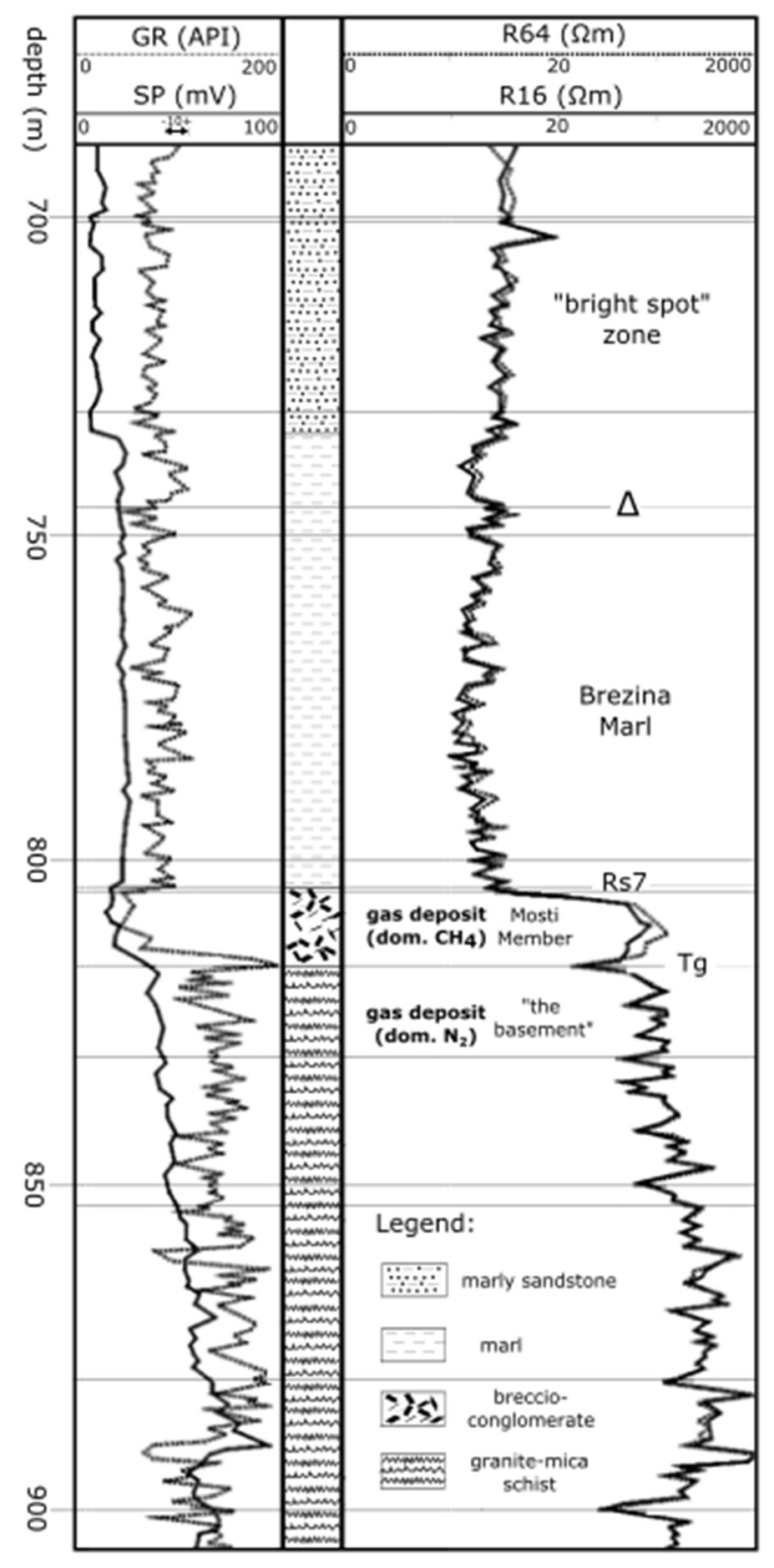


| Pre-Cenozoic–Miocene (16.4 Ma) | Sarmatian–Early Pannonian (11.5 Ma) | Early–Late Pannonian (9.3 Ma) | Late Pannonian–Early Pontian (7.1 Ma) | Early–Late Pontian (6.3 Ma) | Late Pontian–Pliocene (5.6 Ma) | |
|---|---|---|---|---|---|---|
| Transverse Normal Faults (NE–SW) | ||||||
| (1) Primary normal | 300 | 100 | 100–200 | 100 | 100 | 50 |
| (2) Secondary normal | 100 | 100 | 100 | – | – | – |
| (3) Western | 150 | 100 | 100 | 50 | 50 | 50 |
| (4) Štefanje | 50 | 50 | 50 | 50 | 50 | 50 |
| (5) Eastern Marginal | 100 | 100 | Unconformity | Unconformity | 100 | 50 |
| (6) Uljanik | 100 | 100 | Unconformity | Unconformity | 100 | 50–100 |
| Diagonal Faults (WNW-ESE) | ||||||
| (7) Bilogora | 200 | 100 | 100–200 | 100 | 50 | 100 |
| (8) Šandrovac-Ciglena | 50 | 100 | 100–200 | 50 | 50 | 50 |
| (9) Primary reverse | 200 | 100 | 100 | 100 | 100 | 50 |
| (10) Secondary reverse | 200 | 100 | 50–100 | 100 | – | – |
| Categories and Variables | Probabilities for Particular Structure in the Croatian Part of the Pannonian Basin System (CPBS) | |
|---|---|---|
| Probability of the Crucial Geological or Engineering Events in the Category (0–1) | Probability for Category | |
| (A) temperature | a1 × a2 × a3 × a4 = | A |
| a1. The present-day temperature in basement rocks is considered as a long-term value. | ||
| a2. Quaternary volcanism is not observed. | ||
| a3. The paleothermal gradient is known at least for the last 100 Ky. | ||
| a4. Heat flux <75 mW/m2 | ||
| (B) sealing properties of rock | b1 × b2 × b3 × b4 = | B |
| b1. Lithological isolator properties need to be proven all around the disposal volume. | ||
| b2. Granite is favorable, magmatic and metamorphic rock types are a necessary condition. | ||
| b3. The sedimentary sequence in the top of granite/magmatics is rich in clayey and fine-grained rocks (claystones, marls…). | ||
| b4. If artificial sealing of the borehole displacement zone is performed, its quality must be proven. | ||
| (C) low petrophysical values + fault zone(s) inactivity | c1 × c2 × c3 × c4 = | C |
| c1. Petrophysical properties (<2%, <10−15 m2) needs to be proven in the entire volume. | ||
| c2. Fault zone(s) must be inactive or with throw less than 50 m in the Quaternary. | ||
| c3. Regional fault zones must be located more than 2 km from the disposal, and the closest fault zone(s) must be cemented. | ||
| c4. Depth of HLW disposal has to be more than 3 km. | ||
| (D) subsurface fluids and aquifers | d1 × d2 × d3 = | D |
| d1. Subsurface fluids and aquifers must be regionally still, i.e., inactive. | ||
| d2. The deep saline aquifers are favorable. | ||
| d3. Regional weathering zones must be absent or separated from the disposal, with enough thick sealing part of basement. | ||
| Structure probability (E = A × B × C × D) | E | |
| Characteristics | Criteria |
|---|---|
| Depth to crystalline basement | <2 km |
| Simple basement structure | No known regional structures, major shear zones, major tectonic features within 50 km |
| Low seismic and tectonic activity | No Quaternary age volcanism or faulting within 10 km |
| Absent flow of fresh groundwater at depth | Absent significant topographic relief to drive deep recharge, old and highly saline groundwater at depth |
| Low geothermal heat flux preferred | <75 mW/m2 |
| Sufficient area for well array | Design-dependent |
| Absent existing contamination | Absent surface or subsurface contamination at the proposed site |
| Minimal disturbances from other surface or subsurface uses | Prefer sites with minor impacts, e.g., wastewater injection, oil and gas activities, groundwater production, mining and potential mineral resources in the bedrock |
© 2020 by the authors. Licensee MDPI, Basel, Switzerland. This article is an open access article distributed under the terms and conditions of the Creative Commons Attribution (CC BY) license (http://creativecommons.org/licenses/by/4.0/).
Share and Cite
Malvić, T.; Pimenta Dinis, M.A.; Velić, J.; Sremac, J.; Ivšinović, J.; Bošnjak, M.; Barudžija, U.; Veinović, Ž.; Sousa, H.F.P.e. Geological Risk Calculation through Probability of Success (PoS), Applied to Radioactive Waste Disposal in Deep Wells: A Conceptual Study in the Pre-Neogene Basement in the Northern Croatia. Processes 2020, 8, 755. https://doi.org/10.3390/pr8070755
Malvić T, Pimenta Dinis MA, Velić J, Sremac J, Ivšinović J, Bošnjak M, Barudžija U, Veinović Ž, Sousa HFPe. Geological Risk Calculation through Probability of Success (PoS), Applied to Radioactive Waste Disposal in Deep Wells: A Conceptual Study in the Pre-Neogene Basement in the Northern Croatia. Processes. 2020; 8(7):755. https://doi.org/10.3390/pr8070755
Chicago/Turabian StyleMalvić, Tomislav, Maria Alzira Pimenta Dinis, Josipa Velić, Jasenka Sremac, Josip Ivšinović, Marija Bošnjak, Uroš Barudžija, Želimir Veinović, and Hélder Fernando Pedrosa e Sousa. 2020. "Geological Risk Calculation through Probability of Success (PoS), Applied to Radioactive Waste Disposal in Deep Wells: A Conceptual Study in the Pre-Neogene Basement in the Northern Croatia" Processes 8, no. 7: 755. https://doi.org/10.3390/pr8070755
APA StyleMalvić, T., Pimenta Dinis, M. A., Velić, J., Sremac, J., Ivšinović, J., Bošnjak, M., Barudžija, U., Veinović, Ž., & Sousa, H. F. P. e. (2020). Geological Risk Calculation through Probability of Success (PoS), Applied to Radioactive Waste Disposal in Deep Wells: A Conceptual Study in the Pre-Neogene Basement in the Northern Croatia. Processes, 8(7), 755. https://doi.org/10.3390/pr8070755









